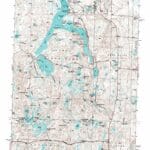Quapaw, Oklahoma, nestled in Ottawa County along historic Route 66, is more than just a small town; it’s the capital of the Quapaw Nation and a testament to tribal resilience. This article delves into Quapaw’s rich history, the environmental and natural disasters it has faced, and the Quapaw Nation’s ongoing fight for justice and revitalization.
A Town Forged in History and Hardship
Quapaw’s story begins long before Oklahoma’s statehood, intertwined with the Quapaw Nation’s journey. Their history likely includes connections to ancient mound builders and documented encounters with European explorers like Hernando de Soto in 1540. The Quapaw people, originally from the Ohio River Valley, eventually settled in Arkansas before being forcibly removed to Oklahoma in 1834. This displacement, a recurring theme in their history, deeply informs their present-day struggles and triumphs. Learn more about the Quapaw Tribe’s experience in Arkansas and their forced removal. [https://www.lolaapp.com/quapaw-ottawa-oklahoma]
The Quapaw Nation: Balancing Progress and Preservation
Today, the Quapaw Nation represents a vibrant blend of Native American traditions and small-town life. They grapple with balancing economic progress and cultural preservation, a challenge faced by many indigenous communities. The Downstream Casino Resort, a major economic driver, has significantly impacted the town’s infrastructure, social dynamics, and overall development. While bringing economic opportunities, it also presents new challenges that require careful consideration.
Cultural Treasures and Community Life
Quapaw boasts several cultural attractions, including the Quapaw Tribal Museum, the annual Quapaw Powwow, and the Downstream Casino Resort, which incorporates elements of Quapaw culture. Those considering making Quapaw their home will find a relatively low cost of living. Exploring the local real estate market, business opportunities, community feel, and schools will provide a clearer picture of life in this unique town. For those interested in exploring other small towns with rich histories, consider visiting Pyote, Texas or Reedsville, WI.
Tar Creek, Tornadoes, and the Fight for Justice
Quapaw’s history is marked by significant environmental and natural disasters, testing the resilience of the Quapaw Nation. The Tar Creek Superfund site, a result of decades of lead and zinc mining, has caused widespread environmental damage and health problems. This contamination has deeply impacted the Quapaw people, making it difficult to live off the land and maintain traditional ways of life. The ghost town of Picher, Oklahoma, within the reservation, stands as a stark reminder of the devastation.
A Community Reeling from Disaster
In April 2014, an EF-2 tornado ripped through Quapaw, compounding the existing hardships. The tornado’s destruction, coupled with the ongoing environmental crisis, created a monumental task of recovery and rebuilding. The Quapaw Nation’s response to these challenges reveals their unwavering commitment to their land and people.
Seeking Justice and Remediation
The Quapaw Nation has been fighting for over a decade to hold the federal government accountable for the environmental damage caused by mining. Their pursuit of $137.5 million in compensation is not simply a financial matter but a fight for environmental justice and the restoration of their ancestral lands. Ongoing research and legal battles suggest that the fight is far from over, but the Quapaw Nation’s persistence offers a beacon of hope.
The Quapaw Tribe in Arkansas: A Story of Displacement and Resilience
The Quapaw, meaning “Downstream People,” originally resided in the Ohio River Valley. They migrated down the Mississippi River, settling in what is now Arkansas. There they thrived for generations before encountering European settlers and the pressures of westward expansion. Treaties signed in 1818 and 1824 resulted in the ceding of Quapaw lands, marking the beginning of their forced migration. In 1834, they were officially removed to Oklahoma, a journey marked by hardship and loss.
A Unique Chapter of Return and Removal
Unlike many other tribes, a significant number of Quapaw returned to Arkansas after their initial removal, driven by a deep connection to their ancestral lands. This return was unfortunately short-lived, followed by a second forced removal, compounding the trauma they had already endured. This back-and-forth movement underscores the turbulent period of Indian Removal and its devastating impact. By 1839, a reservation in northeastern Oklahoma was established for the Quapaw, though their struggles continued, including displacement during the Civil War. what happened to the Quapaw tribe in Arkansas? [https://www.lolaapp.com/quapaw-ottawa-oklahoma]
The Quapaw Nation Today: A Legacy of Perseverance
Today, the Quapaw Nation thrives as a sovereign entity with approximately 5,600 citizens. Their capital, Quapaw, Oklahoma, stands as a symbol of their enduring spirit. They operate successful businesses, establish cultural centers, and actively shape their future while honoring their rich past. Their story embodies resilience, cultural preservation, and self-determination in the face of adversity. Ongoing research continues to shed light on the long-term impacts of their historical journey.
- Unlocking 2-Letter Words with U: The Definitive Guide - April 4, 2025
- Unlock Words with the Letters THREE: Top Unscramble Tools 2025 - April 4, 2025
- Master Scrabble: X & Z Words for High Scores - April 4, 2025

















2 thoughts on “Quapaw, Ottawa County, Oklahoma: A Small Town with Big History and Native American Heritage”
Comments are closed.